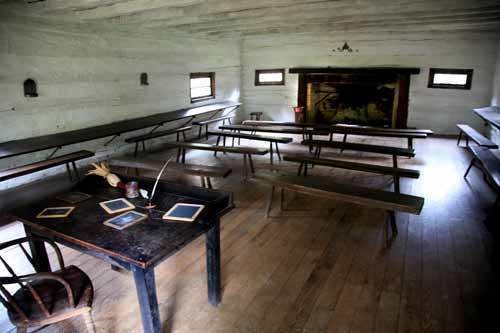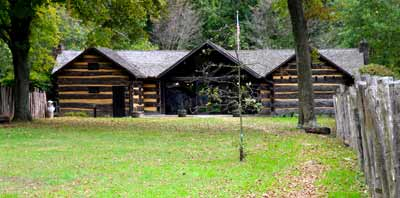
SchoenbrunnVillage
Located in New Philadelphia, Schoenbrunn Village is a reconstruction of an 18th Century village created by Moravian missionaries sent into the Ohio wilderness as missionaries to a group of Delaware living in the area. It is considred to be Ohio's first settlement.
The site is owned by the Ohio Historical Society, but is being operated by the Dennison Railroad Depot Museum located in Dennison. The 17 buildings are open to the public for a small admission fee with seasonal hours (see below).

History
Moravians were from a part of Europe that is today Czech Republic and were pacifists. The group of missionaries and Delawares originally had a village in Pennsylvania, but when the war between the colonists and Great Britain erupted, they decided to move their small village to a more peaceful area in the Ohio Territory. Although the Delaware Nation was quite large, a number of their tribe had converted to Christianity from their contact with the Moravians in Pennsylvania. Because of this relationship, the Christian Delaware donated some tracts of land in the Tuscarawas Valley to the Moravians to establish small villages and churches.
The first group of Moravians consisted of 28 men, women and children, and arrived here in 1772. Their first task was to plant crops, even before building shelters, so they could survive through the following winter. They were led by 51 year old David Zeisberger who had devoted his life since arriving in America to helping the Native Americans. He often served as a translator between the English and Native Americans.
 Between 1772 and 1800, a number of missionary villages were established here in the Tuscarawas Valley similar to what Schoenbrunn Village depicts today, including Gnadenhutten, Lichtenau, Salem and Goshen. It was when war erupted between the colonies and Great Britain, that problems arose among the Native Americans. The Moravians, and likewise the Delaware Christians, were seen to be supportive of the Americans, although this was not necessarily true, but the British perceived them to be pro-America. Because of this perception, the British urged other Native Americans to turn against not only the Moravians, but also the Delaware Christians. Antagonism between the various parties often led to violence and retribution that had unforseen consequences.
Between 1772 and 1800, a number of missionary villages were established here in the Tuscarawas Valley similar to what Schoenbrunn Village depicts today, including Gnadenhutten, Lichtenau, Salem and Goshen. It was when war erupted between the colonies and Great Britain, that problems arose among the Native Americans. The Moravians, and likewise the Delaware Christians, were seen to be supportive of the Americans, although this was not necessarily true, but the British perceived them to be pro-America. Because of this perception, the British urged other Native Americans to turn against not only the Moravians, but also the Delaware Christians. Antagonism between the various parties often led to violence and retribution that had unforseen consequences.
Although relations between the missionaries and the Delaware were for the most part quite good, tragedy befell the Christian Indians in the spring of 1782 when a large group of them returned to the Gnadenhutten to harvest some of the previous years plantings. It was here that a group of Pennsylvania militia who were searching for a group of Native Americans responsible for ravishing several American settlements along the border. When they came upon the peaceful Indians, they assumed that they were those responsible and executed everyone (62 adults and 34 children). This event became known as the Gnadenhutten Massacre.
Later that spring, when a group of Native Americans, including non-Christian Delaware, captured some men on an American military expedition through Central Ohio. After their capture they were told that some of the men may have been involved in the massacre of the Christian Indians earlier that year. Because of this mis-information, they tortured and burned at the stake, Colonel Crawford, the leader of the expedition. The Native American's made the same mistake as the Pennsylvanian militia had made earlier in the year.

Schoenbrunn Village Visitors Center
Visiting Schoenbrunn Village
The reconstructed village is laid out on a plan based on early excavations and journals. Although the original village had approximately 60 buildings on the site, today there are 17 cabins aligned as they likely would have appeared according to these early descriptions. In time Schoenbrunn had a population of 400 mostly Delaware Christians, that also included the Moravian missionaries.
Group tours are available by appointment. The visitor center has a museum covering the the lives of both the Delaware and Moravians. A short video orientation is also available. Tour of reconstructed mission village is self-guided and includes costumed interpreters that describe the activities associated with the various structures and early pioneer life in the area.
Hours:
JUNE - AUGUST
Schoenbrunn Village is open Memorial Day from 9:30 a.m.-5 p.m.
CLOSED
Monday
Tuesday 9:30 a.m. - 5:00 p.m.
Wednesday - Friday 9:30 a.m. - 5:00 p.m.
Sunday 12:00 p.m. - 5:00 p.m.
SEPTEMBER - OCTOBER
Saturday 9:30 a.m. - 5:00 p.m.
Sunday 12:00 p.m. - 5:00 p.m.
CLOSED NOVEMBER - MAY


